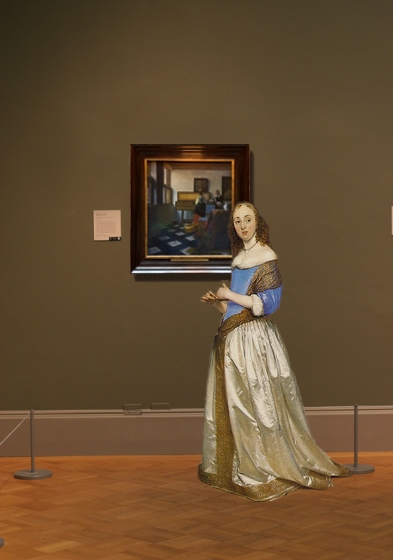The Music Lesson
(De muziekles)c. 1662–1664
Oil on canvas, 73.3 x 64.5 cm. (28 7/8 x 25 3/8 in.)
The Royal Collection, The Windsor Castle
inv. 109
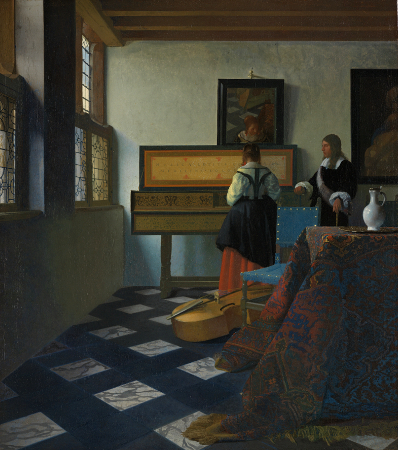
The textual material contained in the Essential Vermeer Interactive Catalogue would fill a hefty-sized book, and is enhanced by more than 1,000 corollary images. In order to use the catalogue most advantageously:
1. Scroll your mouse over the painting to a point of particular interest. Relative information and images will slide into the box located to the right of the painting. To fix and scroll the slide-in information, single click on area of interest. To release the slide-in information, single-click the "dismiss" buttton and continue exploring.
2. To access Special Topics and Fact Sheet information and accessory images, single-click any list item. To release slide-in information, click on any list item and continue exploring.
The ebony framed mirror
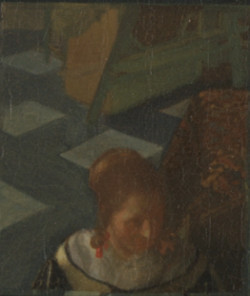
In the ebony-framed mirror, we catch a glimpse of the young girl's face turned slightly to the right, a bit more than one would expect judging by the head of the musician. But the mirror, a technical tour de force that must have been admired by Vermeer's fellow painters, also reveals that a third person was present. On close inspection, we can see part of the foreground carpet and a few floor tiles. With some difficulty, it is also possible to make out the crossbar and a leg of the artist's easel (see the same easel represented in Vermeer's Art of Painting). Thus, with the introduction of the easel, the figure of the artist also takes part in the painting's narrative scheme, reminding the spectator of the intellect that went into the painting's creation.
Mirrors had many meanings in European painting. They could symbolize truth or vanity. In Vermeer's time, the mirror also held strong ties to the art of painting. In his treatise on the art of painting, the painter and art theoretician Samuel van Hoogstraten wrote, "A perfect painting is like a mirror of Nature, in which things that aren't there appear to be there, and which deceives in an acceptable, amusing and praiseworthy fashion." Van Hoogstraten touched upon a lasting dilemma that Vermeer must have felt deeply when he painted: the more the painted image seems real, the more it is deceptive and therefore, potentially morally questionable.
Some critics have drawn a spiritual parallel to the mirror in Las Meninas by Velázquez, even though the two esteemed Baroque artists were unfamiliar with each other's works.
One such ebony-framed mirror was mentioned as being in the front room of Vermeer's house in the inventory of movable items made shortly after his passing.
More about the virginal
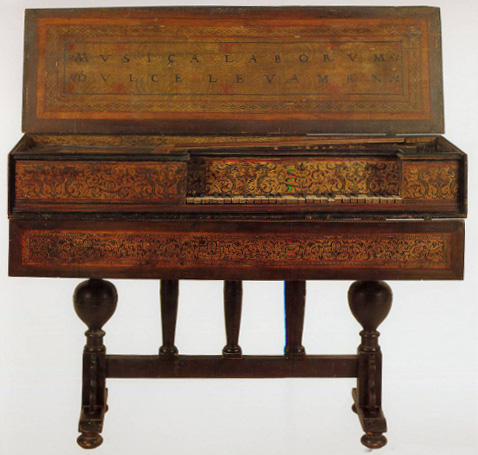
The virginal, also referred to as "virginals" in singular form, is a box-shaped keyboard instrument. In contrast, the more familiar harpsichord resembles a piano with its triangular shape. When closed, the typical Flemish virginal resembles an elongated linen closet. Once opened, its visual impact is remarkable. The keyboard is frequently surrounded by intricate block-printed papers. These papers adorn the front of the case, line the inside of the fallboard, and cover the case above the soundboard and the interior of the lid. Mottoes, such as the one observed on the lid of The Music Lesson, were common decorations. Many of these instruments were designed without legs and were set on a table for use. Later versions came with their own stands, akin to the one seen in The Music Lesson.
It is interesting, that Vermeer not only portrays one of the most expensive musical instruments available but that it was as much as 60 or more years old at the time he painted it. Vermeer must have been aware of its value as he transported it to his studio. We can be reasonably certain that Vermeer could not have afforded to own such an instrument himself. It is also incredibly interesting to to see a Ruckers instrument in a relatively new state even if at 60 years old it might have seemed quite antique to Vermeer.
The lining paper on the keywell of Vermeer's instrument, adorned with flowers, foliage and sea-horses (see facsimile above), is also found on instruments depicted by Metsu (A Man and a Woman Seated by a Virginal) and Steen (A Young Woman Playing a Harpsichord) at the National Gallery in London.

Music composed for the virginal was characterized by rhythmic measures, with timing nuances meticulously thought out and delivered. Lyrics that often paired with the music discussed human and spiritual love and the solace one can derive from it.
While many authors have highlighted that a virginal was viewed as a luxury during that period, Walter Liedtke notes that virginals appear more often in household inventories than generally believed. For instance, two Ruckers virginals were in the possession of the Delft organist Dirck Scholl in the 1660s.

Dirck Scholl
However, it's not unexpected that no keyboard instruments were listed in Vermeer's death inventory of 1676. Dutch music specialist Edwin Buijsen posits that these could have been located in the residence of music enthusiast Cornelis Graswinckel, related by matrimony to Vermeer's patron Pieter van Ruijven. It's also conceivable that Vermeer might have ventured to nearby The Hague to appreciate the renowned collection of musical tools owned by Constantijn Huygens. It's likely he borrowed such tools from his patrons or affluent art enthusiasts he knew.
Regardless of where Vermeer might have encountered the virginal, it's undeniable that it originated from the workshop of the Ruckers family, who led the Antwerp production of keyboard instruments from the end of the 16th century to the mid-17th century. Their devices were sought-after across Europe, with some even reaching South America.
Laboratory assessments reveal that Vermeer modified the virginal's lid shape to enhance the painting's layout. The lid is somewhat broader to the girl's right than her left, a positioning change that diminishes the visual link between the two halves of the lid design through the girl.
The decorative papers on nthe virginals

It has been proven that the virginals in the present work were manufactured by the renowned Ruckers family of Antwerp. The Ruckers family's approach to clavecimbel construction occupies an unparalleled position in organology. Their influence on subsequent harpsichord and virginal designs spread throughout Northern Europe during the 18th century. Some elements of the Ruckers' designs even had an impact on the structure of the contemporary piano. The exquisite sound quality of Ruckers instruments, due to their superior design and meticulous construction of soundboards and bridges, won acclaim by the late 17th century and continued to be celebrated throughout the 18th century. The Ruckers family's contribution to clavecimbel craftsmanship is comparable to Stradivarius's legacy in violin making. Just as Stradivarius violins underwent modifications to meet evolving musical trends and demands, Ruckers clavecimbels were similarly adapted over time.
Many Ruckers instruments were adorned with a combination block-printed papers dreived from pattern books glued on to the inside of the lid, on the keywell (the area surrounding the keys) and occasionally on the case exterior. Some of these patterns echoed textile designs of the period and arabesques while others displayed stylized foliage or other motifs.
A particularly intriguing pattern used by the Ruckers family is the imitation wood-grain pattern found on the lid of the present work, which showcases a clever edge symmetry, centered along the long axis of the paper. When the papers are affixed by rotating each successive piece 180 degress relative to the preceding one, the wood-graining aligns perfectly at the joint between the two papers. The top and bottom of these papers are also ingeniously crafted such that, when one is placed directly over another, the wood-grain pattern of one seamlessly transitions to the next. This creates a repetition cycle so expansive that it easily tricks the eye into believing that the wood-grain pattern, much like that of natural wood, doesn't repeat at all.
Interestingly, the right-hand side of the virginals lid is in this work is depicted in a somewhat different manner than the left. The background colors and the veins of the faux finish are, in essence, inverted.
Cimon and Pero: a Roman Charity in the background
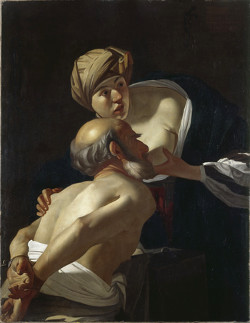
Cimon and Pero (Roman Charity)
Workshop of Dirck van Baburen
1618–1624
Oil on canvas
Like other Dutch genre artists of the time, Vermeer employed background images in his painted mise-en-scène, much as modern stage directors use reproductions, photographs, posters and furniture to define an environment, evoke a mood or provide ironic commentary on a scene. Art historian Gregor Weber identified this picture as originating from the workshop of Dirck van Baburen. Maria Thins, Vermeer's mother-in-law (with whom he and his wife lived until their deaths), already owned a similar work in Gouda. This piece later appeared in the inventory compiled during her legal separation from her husband.
In his depiction, Vermeer shows approximately two-fifths of this "Roman Charity," mainly highlighting the back of Cimon's head and his chained arms. The Roman Charity (or "Carità Romana") tells the notable story of a daughter named Pero, who covertly breastfeeds her father, Cimon, after he's imprisoned and condemned to death by starvation. When a jailer discovers her actions, her act of altruism impresses the officials, leading to her father's release.
How does this image correlate with the two 17th-century Dutchmen engrossed in their music? As John Michael Montias observed, the picture on the wall suggests, by prominently displaying only Cimon in chains, that Vermeer's gentleman is metaphorically shackled, reminiscent of Cimon's literal restraints. This analogy can be further extrapolated: both milk and music, in their unique ways, alleviate the torments of confinement.
An imported carpet

Giovanni della Volta with his Wife and Children (detail)
Lorenzo Lotto
c. 1547
Oil on canvas, 104.5 x 138 cm.
National Gallery, London
By the 13th century, merchant travelers, such as Marco Polo, commented on the beauty of the Oriental carpets they encountered during their journeys. Shortly thereafter, these carpets began to be imported into Venice and subsequently distributed throughout Europe. While early examples of these carpets are seldom preserved, European great masters—from Giotto and Ghirlandaio to Holbein, Van Eyck, Lotto and Vermeer—often depicted those from Turkey and Iran.
Though many carpets appear in Dutch interiors of the time, it might suggest that they were a staple of Dutch households. However, their infrequent mention in death inventories and the scant documentation of these turkse and persiche tapijten in the cargo of Dutch merchant ships indicate otherwise.
It's understood that certain painters provided clients with the carpets themselves, and a single carpet could serve generations of artists. Vermeer, for example, appears to have utilized one particular carpet on multiple occasions.
Carpet expert Onno Ydema notes that the carpet in The Music Lesson is a 16th-century Ushak type from Turkey, and Vermeer depicted it with remarkable accuracy. Most carpets were portrayed as table coverings, displayed with the knotted side facing up. Due to their high value, these carpets were rarely placed on the floor where they might become dirty.
The Ushak carpets, originating from the town of Usak in Western Turkey, are among the most renowned types of Oriental rugs. Especially prominent during the 16th century, their production spans from the late medieval period and continues for many subsequent centuries. These carpets are celebrated for their large-scale, centralized designs, often showcasing medallions as a dominant motif. A central medallion surrounded by smaller, complementary designs is common, though some feature repetitive "all-over" patterns without a distinct central figure.
What sets the Ushak carpets apart is their soft and warm color palette. They predominantly flaunt shades of reds, blues and creamy ivories. With dyes derived from natural sources like plants, they possess a distinct, slightly muted tone. Crafted from high-quality wool, their weave is relatively loose, offering a plush, luxurious feel underfoot.
Their significance isn't just confined to their place of origin. These carpets held a special place in European art, particularly during the Renaissance. Today, the original 16th-century Ushak carpets are rarities, with collectors and museums worldwide valuing them as treasures of historical and artistic significance.
The white wine jug
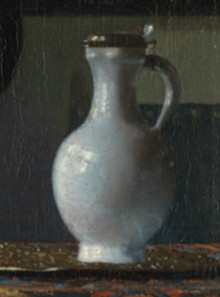
Perched on top of an Ushak carpet, is a thin-necked wine jug with a remarkable creamy-white, tin glaze and topped by a metal lid. These tin-glazed containers were originally produced in Faenza, Italy. In the 1550s, they were exported all over Europe, and by the late 16th and early 17th century, had become very fashionable. In Holland, they were imitated by local potters. They appear in numerous genre interior paintings between 1650 and 1670. Although it is very difficult to distinguish between Italian and Dutch versions, historian of the Dutch decorative arts Alexandra Gaba van Dongen believes that the ones in Vermeer's paintings are Italian.
The vase is set upon an elaborately decorated silver tray. Rich urban dwellers often invested their money in furniture, silver objects, carpets, tapestries and porcelain, which in many cases were considered more valuable than paintings that hung nearby. The extravagant embossing and engraving of silver objects perfected by the best Dutch silversmiths required years of training and enormous skill. Some were the greatest artists of their time.
Curiously, for many Dutchman, paintings did not possess a comparable artistic "aura" as they do today and were collected for a variety of reasons.
The windows of Vermeer's studio

Young Woman with a Water Pitcher (detail)
Johannes Vermeer
c. 1662–1665
Oil on canvas, 45.7 x 40.6 cm.
Metropolitan Museum of Art, New York
This is the only painting in Vermeer's oeuvre that shows two sets of windows. A third window outside the picture casts light on the artist's workstation. The design of the panes is comparable to those in the Young Woman Holding a Water Pitcher.
Such windows typically consisted of four casements. The bottom two had shutters on the outside (see Vermeer's Little Street) and at times, two upper shutters attached on the inside. The shutters controlled incoming light and airflow. Curtains were also hung to filter light and keep out indiscreet eyes from outside. Presumably, the two windows in The Music Lesson faced north onto the central Market Square. Painters have always preferred northern exposure for their studios since northern light is cooler and relatively constant throughout the working day.
On overcast or rainy days, the artist may have found more productive things to do than paint his brightly lit pictures. Perhaps, the brighter works were scheduled for the summer months when light was more abundant. In any case, Vermeer's studio was well-lit; approximately 40% of the area of the wall visible on the left was occupied by windows. According to estimates made by Steadman, this studio was about 6.6 meters deep, 4 meters wide, and about 3 meters high.
As in all of Vermeer's paintings (and this distinguishes them from works by his contemporaries), this window reveals no view outside, heightening the sense of privacy and silent dialogue between the figure.

A Girl in a Window with a Bunch of Grapes
Attributed to Gerrit Dou
1662
Oil on panel, 38 x 29 cm.
Galleria Sabauda, Turin
Hans Slager, a Dutch archivist, has noted that, so far, of the eight windows in Vermeer's work that feature the same central, quatrelobed geometric design as in the Music Lesson, only three have been identified in the works of other artists. One is by Gerrit Dou (1613-1675), titled Girl at Window with a Bunch of Grapes, dated 1660, and is housed in the Royal Collection Trust, UK. Another nearly identical piece by Dou from 1662 is in a private collection belonging to Prinz Eugen von Savoyen in Vienna/Turin. There's also one by Pieter Cornelisz Slingelandt (1640-1691), titled Lacemaker Buying a Cock Through the Window, located in Gemäldegalerie Alte Meister, Dresden, from 1672.
The timber rafters

Willem Weve, a historian of Delft architecture, notes that although domestic construction was not standardized in the city in the mid-17th century, the type of ceiling shown in this painting is one of several arrangements used in houses, and surviving examples can indeed be found. The timber members are small beams, probably of pine, supported by a wall plate over the windows, which can clearly be seen at the top left of The Music Lesson. The beams were supported at their other ends on a wall that was to the right of Vermeer's scenes, always out of sight. The ceiling beams in Vermeer's works seem to all slope downwards from left to right. The fact that they slant in the three instances in which they are represented suggests the possibility that this is a real geometrical property of the room and not an inaccuracy in Vermeer's drawing.
Wooden beams and rafters provided essential structural support for the houses. They bore the weight of the roof and upper floors, distributing it evenly across the structure and preventing potential collapses. When combined with thatch or other roofing materials, wooden rafters provided a certain degree of insulation. This was crucial in the colder months, ensuring that homes retained heat more efficiently.
The "Spanish" chairs
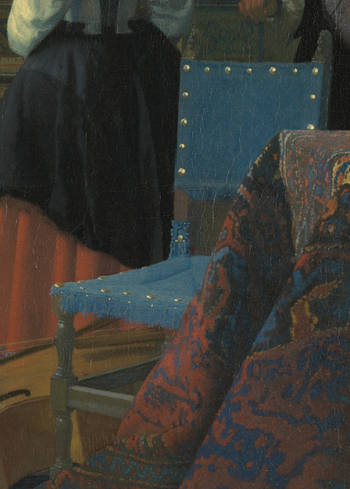
Vermeer, like many of his colleagues, depicted these common so-called Spanish chairs numerous times. The basic model originated in Spain in the 15th century and quickly spread throughout Europe. Typically, the chair legs are smooth, rounded and slender. They can be baluster-shaped or twisted.The seats, often made from embossed leather, sometimes colored or even gilded, were attached to the wooden frame using decorative nail heads. Beyond serving a functional purpose, the leather added an element of comfort and sophistication. This piece of furniture is distinctly bourgeois and was produced in large quantities. It is likely that the hand-carved lion-head finials were crafted by a specialized artisan or sculptor.
A particularly notable feature of many Spanish chairs is the lion-head finials, ornate carvings of lion heads holding rings in their maws, that usually adorn the top ends of the chair's uprights. These finials, representative of strength, nobility and majesty, were likely the handiwork of specialized artisans or sculptors, exemplifying the meticulous craftsmanship of the time.

The two Spanish chairs in the Music Lesson are probably identical to those in the Woman in Blue Reading a Letter. Both feature slender lion-head finials, blue upholstery and brass tacks to affix the upholstery to the chair. The color of the upholstery—most likely cloth rather than the traditional leather associated with chairs of this type—in the Music Lesson is much lighter. Whether this is due to artistic license or a phenomenon called ultramarine sickness, or ultramarine disease, is not known. The structure and upholstery of the foreground chair in The Music Lesson can be seen in greater detail than in its counterpart, where the fringes and wooden structure are hidden from sight.
Ultramarine was traditionally produced by grinding lapis lazuli rock from mines in Afghanistan into a fine powder and blending it with oils and waxes. It was the most expensive blue used by Renaissance painters, even more precious than gold. However, a synthetic version was invented in 1826, making it far cheaper.
Ultramarine sickness results when the paint becomes a dulled gray-blue color, which curiously occurs in both the natural and synthetic versions of the pigment, even though there are also many examples of well-preserved ultramarine blue paint layers in paintings that are hundreds of years old. Previously, researchers attributed the malady either to pigment loss or to tiny cracks forming between pigment particles and organic binders in the paint, causing light to scatter and dull the perceived color, despite the blue pigment still being present. Recent investigation indicates that the alteration of the paint's color is caused when ultramarine blue pigments are exposed to UV (ultraviolet) light, which triggers a reaction that damages the paint's binding material (linseed or walnut oil used to grind the finely powdered pigment into a paste) through a method involving unstable molecules called free radicals.
The study of pigment degradation is a complex field. There are ongoing efforts to understand, prevent, and reverse damage to historic artworks.
The viola da gamba
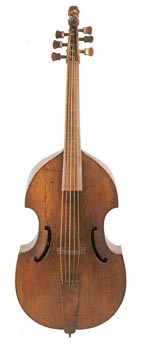
This viola da gamba did not appear in the initial concept of work but was presumably added in a later stage for compositional and/or iconographic motives.
The viola da gamba makes four minor, but symbolically significant, appearances in Vermeer's musical-themed paintings. In all four paintings it remains quietly unattended, never played. Art writers have speculated that someone, presumably a male suitor, will gather it up and mae music. Together with the lute, the viola da gamba is probably the most frequently represented instrument throughout the centuries, whether in painting, sculpture or miniature. Its soft but clear tone imitates the human voice and is the perfect complement for the lute. Its deep tone and unusual stature are associated with the male while the virginal is associated with the female.
The marble floor tiling: fact or fiction?

Dutch art specialists generally agree that Vermeer did not paint the marble floor tiles seen in many of his pictures from life, which lend these pictures an unmistakable stately air. Such a luxurious domestic feature, destined only for the very rich, was economically out of reach for both Vermeer and his mother-in-law with whom he lived., an in whose house he kept his studio for many years. Period inventories reveal that marble floors, rare in any case, were generally restricted to one room, the voorhuis (the main entrance), where they would have been seen and appreciated by visitors. Simple wooden floors with large planks were far more practical during the long, cold Dutch winters and were standard features even in the wealthiest Dutch homes. To see real marble floors, Vermeer would have had to take a short walk to the Delft Town Hall or the a longer walk to the nearby princely palace in Rijswijk.
The painting of marble tiles must have served a three-fold purpose for Dutch interior artists: to intensify the illusion of spatial depth, to demonstrate the artist's command of perspective, and to create richly decorated environments that would appeal to upper-class clients.
Since the tiles of Vermeer's floor could not have been painted from life, he may have devised a grid system from real ceramic tiles, which were much less costly than marble tiles, in his studio. The grid could then be adapted to the compositional needs of each work of art. In the present work, the white tiles were isolated to avoid creating an accelerated perspective that pulls the viewer's eyes too swiftly to the back of the painting. This same tile scheme is never repeated.
Differently from De Hooch and almost every other Dutch interior painter of the time, Vermeer always set the tiles of his scenes diagonally to the picture plane. The imaginative De Hooch experimented with many different patterns, with some scenes showing both perpendicular and diagonally set tiles. The veining of Vermeer's white tiles is often strangely calligraphic, out of key with the broader stylistic register of the painting.
Since the Netherlands does not have native sources of marble, the Dutch were obligated to import it for construction and artistic purposes, making it very costly. The area now known as Belgium, particularly the region of Wallonia, was historically a major source of fine marbles. The red, black and gray marbles from this region were particularly prized. Italy is renowned for its high-quality marble, especially the white marble from Carrara. Many sculptures and decorative elements crafted in the Dutch Republic during the Golden Age would have been made from Italian marble.
The gentleman: a teacher or a suitor?
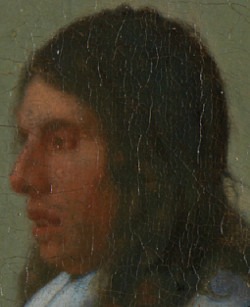
What is going on in The Music Lesson is not so obvious. Some critics have pointed out that the men who appear in Vermeer's group paintings seem to have been intentionally relegated to an oddly passive role. In this case, the upright gentleman has been identified as a music teacher, rather than a partner, based on his authoritative pose and the themes of analogous paintings by Vermeer's colleagues. Walter Liedtke notes that the man's mouth is open, suggesting that he must be singing. Since no music books are visible, he must know the music by heart.
It has been pointed out that the back of the musician obscures the hands of the standing musician and part of the motto on the virginal's open lid. Dutch art expert Arthur K. Wheelock Jr. suggested that Vermeer intended to "emphasize less the specifics of the woman and her music and more the abstract concepts her music embodies: joy, harmony in love, healing and solace. Thus, the theme of healing and solace...is reinforced through the painting partially visible on the rear wall, a depiction of Cimon and Pero, a story taken from Valerius Maximus known as Roman Charity.
Music teachers, who were often stereotyped and free spirits, would travel from home to home, providing private lessons, mostly to young women who sought to enrich their cultural lives and to expand their means of conveying personal feelings. Small ensembles would come together in domestic settings to share the joy of playing in harmony and to entertain friends and relatives. These ensembles would bring their own instruments and carefully study the printed score.
Technical examinations have shown that Vermeer initially positioned the man closer to the girl. The girl's head was also once turned more toward the man, as reflected in the mirror. By moving the man further away and turning the girl's head back, Vermeer altered their relationship, allowing them to fit more harmoniously within the overall composition.
The yellow satin jacket
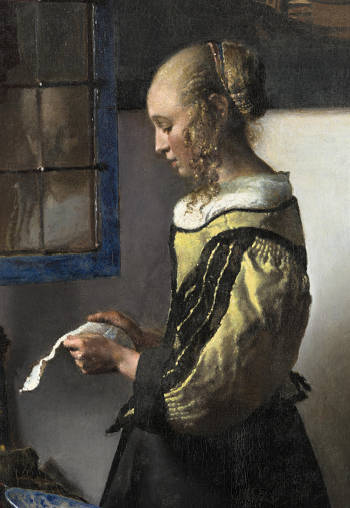
Girl Reading a Letter at an Open Window (detail)
Johannes Vermeer
c. 1657–1659
Oil on canvas, 83 x 64.5 cm.
Gemäldegalerie Alte Meister, Dresden
The young musician wears a light satin yellow jacket that can be found in four other works. Marieke de Winkel, a Dutch costume expert, observes that this kind of garment was typically worn as daily wear and was sometimes called a schort, except in Leiden, where it was referred to as a wacht, although in Vermeer literature, it has been erroneously identified as a caraco or a pet en l'air, both of which refer to a later and somewhat different type of garment.
Only a few examples of these bodices have survived. One stunning a example can be found in London, made of pale blue watered silk and closes at the front,
likely dating from around 1655. Another is housed in the Hessisches Landesmuseum Darmstadt, which boasts a rare collection of well-preserved doublets and bodices from Cologne.
The schort fits tightly around the bust, drawing in the waist and pushing up the bosom to create an hourglass figure. It was likely internally boned or worn over a stay. With its smart cut, wide neckline, fine black trim and short puffed sleeves, it must have appealed to the painter's eye, and to the tastes of his wife, who probably owned it. With such a garment, a lady would wear a skirt equally made of silk satin and falling to the ground in soft pleats. The painter's fondness for this garment is evident by the number of times he portrayed it and the detailed attention he gave it. Its depiction varies slightly from one work of art to another.
Painting the white-washed wall
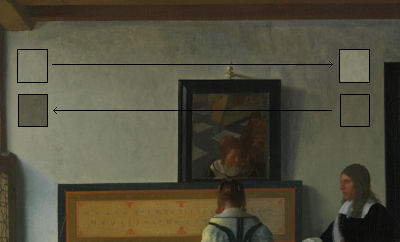
The background wall of Vermeer's Music Lesson offers a clear example of the challenges present in highly illusionistic painting. In Vermeer's work, light streams through an open window from left to right, raking obliquely across the uneven, uniformly colored surface of the wall. As its intensity gradually diminishes, the right-hand side of the wall is, according to optical laws, somewhat darker compared to the area near the window. But due to the perceptual mechanism known as brightness constancy, the human visual system tends to suppress these gradual changes in brightness. Therefore, an untrained observer in a room similar to Vermeer's will perceive the entire wall as uniformly white, and not notice the differences in the light's intensity. However, to convey the sensation of light weakening, the painter must use light gray paint near the light source and a considerably darker gray for parts further away. The difference in tonal value (gradations between white and black) between these areas is always more significant than one might anticipate, as evident in the provided diagram, in which two patches of the background wall have been switched to highlight our tendency to view the wall as uniformly light gray.
special Topics
- Is this a real scene?
- A Vermeer in Venice
- The harmony of two souls in love
- What was Vermeer's studio like?
- Vermeer, geometry, and Piet Mondriaan
- Jacob Cats and the Dutch emblem book
- Decorations on the Flemish virginal
- Expressive meaning in perspective
- Love shines
- Vermeer's shadows
- Listen to period virginal music
Critical assessment
Comparing the girl with her reflection we can notice that the back of her head, directly seen, is more conventionally perceived, more recognizable, perhaps more touching, her reflected face, its detail dissolved, its humanity suspended in light, has a deeper kind of completeness. The face is reflected not only in the mirror but also in the painter's temperament. For the first time, we have the sense that he has used, however oblique, for the whole of human appearance.
Lawrence Gowing, Vermeer, 1952
The signature

Signed lower picture frame at right IVMeer (IVM in monogram)
(Click here to access a complete study of Vermeer's signatures.)
Dates
1664
Albert Blankert, Vermeer: 1632–1675, 1975
c. 1662–1664
Arthur K. Wheelock Jr., The Public and the Private in the Age of Vermeer, London, 2000
c. 1662–1663
Walter Liedtke, Vermeer: The Complete Paintings, New York, 2008
c. 1662–1665
Wayne Franits, Vermeer, 2015
(Click here to access a complete study of the dates of Vermeer's paintings).
Technical report
The plain-weave linen support has a thread count of 15 x 14 per cm². The original tacking edges have been removed. Cusping occurs on all sides, more pronounced along top and bottom edges. The canvas has been lined.
The light brownish gray ground contains lead white, chalk and a little umber, with aggregates of lead white particles. The paint is thinly and smoothly applied although some texture is present, as on the nearest edge of the bass viol, which stands out due to curling impasto.
The bottom half of the painting has a strong blue cast. The dark tiles in the foreground are blue while those further back in the composition are dark gray and contain no blue pigment. The shadow of the carpet on the table in the right foreground is dominated by a bright blue, which may be discolored. A pinhole with which Vermeer marked the vanishing point of the composition is visible in the paint layer.
* Johannes Vermeer (exh. cat., National Gallery of Art and Royal Cabinet of Paintings Mauritshuis - Washington and The Hague, 1995, edited by Arthur K. Wheelock Jr.)
Provenance
- (?) Pieter Claesz. van Ruijven, Delft (d. 1674);
- (?) his widow, Maria de Knuijt, Delft (d. 1681);
- (?) their daughter, Magdalena van Ruijven, Delft (d. 1682);
- (?) her widower, Jacob Abrahamsz Dissius (d. 1695);
- Dissius sale, Amsterdam, 16 May, 1696, no. 6;
- Giovanni Antonio Pellegrini, Amsterdam/The Hague (1718), Venice (1741);
- his widow, Angela Carriera, Venice (1741–-1742);
- Joseph Smith, Venice and Mogliano (1742–1762);
- King Georg III, Windsor Castle, as by Frans van Mieris, (1762 acquired with the Smith Collection);
- since 1762 Royal Collection, Windsor Castle and Buckingham Palace (inv. 109).
Exhibitions
- London 1876
Exhibition of Works by Old Masters and by Deceased Masters of British School
Royal Academy of Arts
no. 211 - London 1895
Catalogue of the Loan Collection of Pictures
Art Gallery of the Corporation of London
92–93, no. 127, as "The Music Master, and Pupil," lent by Her Magesty the Queen - London 1929
Exhibition of Dutch Art, 1450–1900
Royal Academy of Arts
144, no. 305 and pl. 78 - London January 4–March 9, 1929
Dutch Art. An Illustrated Souvenir of the Exhibition of Dutch Art at Burlington House, London
Burlington House
89, no. 107 and ill. - London 1946
Catalogue of Exhibition of the King's Pictures
Royal Academy of Arts
108, no. 305 - The Hague August 6–September 26, 1948
Masterpieces of the Dutch School from the Collection of H.M. the King of England on the Occasion of 50-year Reign of Queen Wilhelmin
Mauritshuis
30, no. 10 and ill. - London November, 1952–March, 1953
Dutch Pictures, 1450–1750
Royal Academy of Arts
1: no. 515, 2: ill. 45 - London July–September, 1971
Dutch Pictures from the Royal Collection. The Queen's Gallery
Buckingham Palace
19 and 74, no. 10 - Philadelphia March18–May 13, 1984
Masters of Seventeenth-Century Dutch Genre Painting
Philadelphia Museum of Art
344–345, no. 119 and ill. 109 - Berlin June 8–August 12, 1984
Masters of Seventeenth-Century Dutch Genre Painting
Gemäldegalerie, Staatliche Museen Preussischer Kulturbesitz
344–345, no. 119 and ill. 109 - Washington D.C. November 12, 1995–February 11, 1996
Johannes Vermeer
National Gallery of Art
128–133, no. 8 and ill. - The Hague March 1–June 2, 1996
Johannes Vermeer. Royal Cabinet of Paintings
Mauritshuis
128–133, no. 8 and ill. - London February 11–October 30, 2005
Enchanting the Eye: Dutch Painters of the Golden Age
The Royal Collection, Buckingham Palace - London March, 2011
Masterpiece a Month: Presiding Genius
Johannes Vermeer–"A Lady at the Virginals with a Gentleman" (The Music Lesson)
The Dulwich Picture Gallery - Cambridge October 5, 2011–January 21, 2012
Vermeer's Women: Secrets and Silence
The Fitzwilliam Museum
204, no. 26 and ill. - London June 26–September 8, 2013
Vermeer and Music: Love and Leisure in the Dutch Golden Age
National Gallery
62, no. 21 and ill. - London November 13, 2015–February 14, 2016
Masters of the Everyday: Dutch Artists in the Age of Vermeer. An Exhibition from the British Royal Collection
The Queen's Gallery, Buckingham Palace - Edinburgh March 4–July 24, 2016
Masters of the Everyday: Dutch Artists in the Age of Vermeer: An Exhibition from the British Royal Collection
The Queen's Gallery, Palace of Holyroodhouse - The Hague September 29, 2016–January 8, 2017
Masters of the Everyday: Dutch Artists in the Age of Vermeer: An Exhibition from the British Royal Collection
Mauritshuis - London December 11–January, 2022
Masterpieces from Buckingham Palace
The Queen's Gallery, Buckingham Palace, London
(Click here to access a complete, sortable list of the exhibitions of Vermeer's paintings).
Did the scene pictured in Vermeer's painting ever exist?
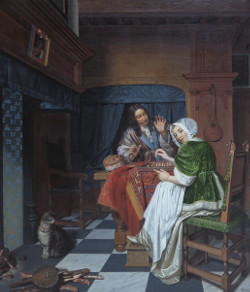
The Chess Players
Cornelis de Man
1670
Oil on canvas, 97.5 x 85 cm.
Museum of Fine Arts, Budapest, Hungary
The quintessential, pristine Dutch interior in The Music Lesson does not accurately reflect Vermeer's personal circumstances and might have been largely contrived. It's widely known that luxury items such as carpets, marble flooring, silver trays and musical instruments, all of which appear in the same room, were rarely found except in the wealthiest households. Conversely, few of the common household items listed in the artist's posthumous inventory, including cradles, beds and worn furniture, ever made their way into Vermeer's impeccable compositions. Artists of genre interiors, like Vermeer, were selective in their subject matter.
In general, the number of furnishings in Dutch homes was likely far greater than what is represented in Vermeer's works of art. Vermeer's uncluttered and meticulously ordered spaces were intentionally composed and painted to convey an idea of harmony, peace and the elegance of refined living. These images would have resonated with married couples who displayed them in their homes. Such portrayals are more akin to cinematic mise-en-scène than to candid snapshots of everyday life.
Therefore, Vermeer might be described as a metteur en scène, or "putter on scene" (the French title given to a film director), who meticulously orchestrates sets, props, actors, costumes and lighting in his compositions.
The harmony of two souls in love
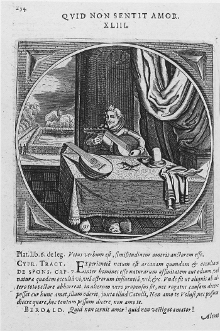
Jacob Cats
"Quid Non Sentit Amor"
Proteus, ofte, Minne-beelden verandert in sinne-beelden
1627
National Gallery of Art Library, Washington D.C.
Music, being an art form deeply rooted in emotion and expression, was an apt metaphorical vehicle for exploring various themes, especially love. Instruments were not merely tools of music but were seen as carriers of meaning. The virginal, for instance, was an apt symbol for a young maiden, given its name and its delicate and intricate sound. The bass viol, being a more resonant and deeper-sounding instrument, often symbolized the male counterpart. Their juxtaposition, as seen in Vermeer's Music Lesson, becomes a harmonious dialogue between the two, mirroring the relationship between a man and a woman.
For viewers familiar with Cats' emblems or the symbolic vocabulary of the time, Vermeer's painting would offer more than just a visual treat. It would resonate on an emotional level, echoing sentiments of love, harmony and the profound connections that bind individuals together. Jacob Cats, a renowned Dutch poet of the time, was known for his popular emblembooks, which contained short poetic verses accompanied by an illustration, often drawing connections between everyday objects and moral or philosophical insights. His emblem Quid Non Sentit Amor (What Doesn't Love Feel?) beautifully encapsulates the idea that love, like music, knows no bounds. Even when two instruments are not played together, the resonance of one can affect the other, much like two lovers whose hearts are intertwined regardless of distance.
What was Vermeer's studio like?
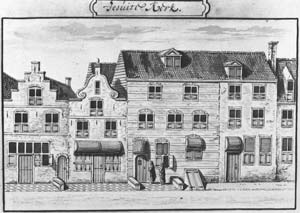
The Jesuit Church on the Oude Langendijk in Delft
1700–1725
Abraham Rademaker
Brush and gray ink, 132 x 202 mm.
Gemeentearchief, Delft
Although much has been theorized about Vermeer's working methods in conjunction with the room(s) in which he worked, we do not know how many different rooms he worked in, or even the house in which his studio was located. However, informed specialists believe that Vermeer worked in at least three different environments during his twenty-year career. He did not work in the modest circumstances in which artists such as Rembrandt and Adriaen van Ostade portrayed themselves.
From 1660, it is known that Vermeer was living with his mother-in-law, Maria Thins, on Oude Langendijk, directly across his father's inn, Mechelen on the Market Square in the center of Delft. Vermeer's biographer, John Michael Montias, believed that the Thins house is pictured on an 18th-century drawing by Abraham Rademaker of a Jesuit church on Oude Langendijk (the Thins/Vermeer house is the furthest one to the right but may also be one or two houses over to the right, just outside the drawing). The drawing shows us a series of modest houses, each with a ground floor, an upstairs floor, some with an extra floor, and an attic.
The Music Lesson provides most probably a very good idea of how Vermeer's studio was structured.
Given the meticulous detail and precision evident in Vermeer's paintings, his studio would have been a space of great importance and influence on his works. Studios during the 17th century varied greatly based on the artist's financial standing and specific needs. A well-lit space was crucial for painters, so large windows were a common feature. Considering Vermeer's mastery in portraying light and shadow, his studio likely took advantage of natural lighting.
Jacob Cats and the Dutch emblem book
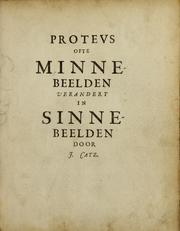
Title page of Sinne- en minnebeelden
Jacob Cats
Amsterdam (1627)
Gemeentearchief, Delft
Art historians believe that emblematic literature constitutes one of the prime resources for comprehending the hidden meaning in Dutch genre painting. In the present work, an emblem by Jacob Cats, Quid Non Sentit Amor (What does love not perceive? or"What doesn't love feel?), which emphasizes the depth and comprehensiveness of the emotions and perceptions associated with love), has often been referenced.
Although Cats was not widely known outside of Holland, among his own people for nearly two centuries he enjoyed enormous popularity. His countrymen showed their affection by nicknaming him "Father Cats." However, the antiquated character of his content and diction have come to be seen as obstacles to study, and today he is more renowned than read.
Cats earned his doctorate in law at Orléans, practiced in The Hague, and, after visits to Oxford and Cambridge, settled in Zeeland, where he accumulated wealth through land reclamation. As he advanced in his career, he became a magistrate and successively served as pensionary of Middelburg and Correct. From 1636 to 1651, he held the position of grand pensionary of Holland. He participated in diplomatic missions to England: in 1627 to Charles I and, unsuccessfully, to Cromwell in 1651–1652. His background provided him with an international perspective, and he felt an affinity with many English Puritan writers.
His first book, Sinne- en minnebeelden (1618; Portraits of Morality and Love), included engravings accompanied by text in Dutch, Latin and French. Each image had a threefold interpretation, symbolizing what Cats perceived as the three pillars of human life: love, society and religion. Perhaps his most notable emblem book is Spiegel van den ouden ende nieuwen tijdt (1632; Mirror of Old and New Times" from which many quotations have become widely recognized. This work is penned in a more colloquial style than his earlier endeavors, favoring popular Dutch over the classical version.
Decorations on the Flemish virginal

Most Flemish virginals had their soundboards painted with flowers, fruit, birds, caterpillars, moths and even cooked prawns, all within blue scalloped borders and intricate blue arabesques. Natural keys were normally covered in bone, and sharps were of oak or, less commonly, chestnut. The case exteriors were usually marbled like the ones in Vermeer's Lady Standing at a Virginal and A Lady Seated at a Virginals.
The decorative papers on the front side of virginals in Vermeer's Music Lesson are intricately detailed, suggesting the use of a camera obscura by the artist for precision. These papers, found on surviving Ruckers virginals, contain unique motifs. Though largely mirrored symmetrically, there are slight variances; for instance, one side of the fleur-de-lys motif has three petals, while its mirrored counterpart has just one, a detail consistent with Vermeer's representation.
Members of the Ruckers family, renowned instrument makers, employed various printed paper designs. Grant O'Brien identified three main dolphin motif printed block papers used by the Ruckers and Couchet builders. The earliest, referred to as "Type 3 earlier type", displays the asymmetrical fleur-de-lys elements. A subsequent version, "Type 3 later type", has mirrored design elements but retains the fleur-de-lys differences. A third design, "Type 4", presents a negative version of the pattern. Close examination of the Vermeer painting reveals that the "Type 3 early type" design was used on the depicted virginal.
The instrument in Vermeer's painting shows numerous features common to Hans Ruckers' instruments, from lid paper patterns, border papers and key front designs. Despite the lack of a clear date, these elements suggest that the instrument was made by a member of the Ruckers family between 1583 and 1623.
Occasionally, the inside of the lid bore a decorative scene; more often it was covered with block-printed papers embellished with a Latin motto, usually connected with morality or music. Some typical mottos include:
SIC TRANSIT GLORIA MVNDI
(Thus passes the glory of the world)
MVSICA DVLCE LABORVM LEVAMEN
(Sweet music is the solace of labor)
MVSICA DONVM DEI (Music is the gift of God)
The Motto on the virginal in Vermeer's Music Lesson reads:
MVSICA LETITIAE CO[ME]S MEDICINA DOLOR[VM]
(Music is the companion of joy, balm for sorrow)
The motto also decorates virginals in paintings by Pieter Codde, Gonzales Coques and Karel Slabbaert as well as harpsichords made in 1624 and 1640 by Andreas Ruckers of Antwerp.
The expressive meaning in perspective
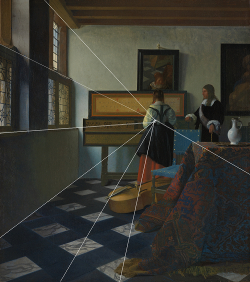
By the time Vermeer painted The Music Lesson, he had fully mastered his medium. He had acquired the ability to utilize every stylistic and technical aspect to enhance the meaning of his images, including linear perspective, a crucial tool for organizing composition and creating the illusion of spatial depth.
Perspective was highly valued because it allowed the artist to give the viewer the illusion that the painted scenes were real, a primary goal of Dutch realism. A rare contemporary account of Vermeer's art referred to his pieces not as "timeless moments" but "perspectives." Perspective was also significant because it offered a mathematical foundation for painting, a fact that could elevate its traditional status from the Mechanical Arts to the Liberal Arts. This idea likely held considerable significance for Vermeer, who later dedicated his most notable work, Art of Painting, to elevate the status of the painter.
In ancient times, the Liberal Arts were deemed suitable pursuits for free and noble citizens, set above the tasks of handicrafts. Arithmetic, Geometry, Astronomy and Music represented the scientific Liberal Arts due to their foundation in mathematics. Grammar, Dialectic and Rhetoric represented the rational side as they focused on language. In contrast, both painting and sculpture were categorized among the mechanical arts because they involved manual labor.
Vermeer employed perspective not only to introduce depth but also to amplify his message. In the current piece, the orthogonals of the perspectival system center on the standing young musician, the spiritual heart of the painting.
Recent discoveries by the painting conservator Jørgen Wadum reveal that Vermeer utilized a straightforward technique, commonly used among Dutch artists who valued perspective. X-ray evaluations of Vermeer's surviving works show that in thirteen pieces with intricate perspective challenges, there exists a tiny hole (subsequently filled with paint) that always aligns precisely with the perspective's vanishing point. A pin was once inserted into this hole (likely into a wood panel temporarily attached to the canvas's back), and a string was tied to it. By applying chalk to the string, the artist could pull it tight and snap it to produce a perfectly straight orthogonal on the canvas's surface, which could then be traced. During the painting's later stages, the tiles' intricate perspective could be easily verified by stretching the string just above the canvas's wet surface.
This method, however, is in itself insufficient to devise the more complex perspectives that we see in Vermeer's highly elaborately constructed works, like the present work and The Art of Painting. While it creates orthogonals with great precision, it cannot be used to determine the proportions of the objects seen in the paintings, nor establish their mathematical position in space. It seems likely that Vermeer was familiar with the basics of linear perspective, which, combined with the string-and-pin method and the camera obscura, could have achieved the level of precision we see in his perspectives.
Listen to period music
![]() "A Toye" [1.30 MB]
"A Toye" [1.30 MB]
Giles Farnaby (c. 1563–1640)
from: Ancient Instruments – Tuxedo (various artists)
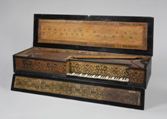
Together with the harpsichord, the virginal (or virginals) likely has its origin in the medieval psaltery, to which a keyboard was applied to facilitate the playing of polyphonic music (i.e., melody with accompanying chords). It is first mentioned around 1460 in a treatise by Paulus Paulirinus of Prague. Although the virginal had limited tonal resources, it held a significant position in musical life during the 16th and 17th centuries. Its size was more compact, its design simpler and its cost lower than the harpsichord. As a result, the harpsichord is infrequently depicted in works of art, drawings and other mediums.
Antwerp was the primary center for virginal production, and for keyboard craftsmanship in general, thanks to the esteemed Ruckers and Couchet families. Italy was the secondary hub. England also showed a fondness for the instrument, especially after King Henry VIII acquired five virginals. Up until the 18th century, the virginal was used as a solo instrument in private music gatherings, and to accompany singing voices or melodic instruments, such as the viola da gamba.
The virginal's design typically features a rectangular case, but polygon shapes in various sizes were also crafted. Its metal strings run parallel to the keyboard and are plucked by plectra attached to jacks. The jacks (one corresponding to each key) are set in pairs, spanning from the instrument's front left to its back right. These jacks pluck in opposing directions, so adjacent pairs of jacks are separated by tightly arranged string pairs. A single slot in the soundboard usually accommodates each jack pair, with another slot situated below in a thin guide situated above the keys. Leather padding on both the soundboard and the lower guide ensures a quiet bearing surface for the jacks.
The typical Flemish muselar type, likely devised by Hans Ruckers, has its keyboard on the right side. The strings of this design are plucked near their center throughout their range, producing a strong, flute-like sound. However, the jacks and keys for the left hand are centrally located on the instrument's soundboard, amplifying any mechanical noise they produce. The central plucking point of the bass strings complicates repetition, as the vibration of a still-sounding string hampers the plectrum's ability to strike again. As a result, the muselar is more apt for melodic music without intricate bass passages.
Love shines
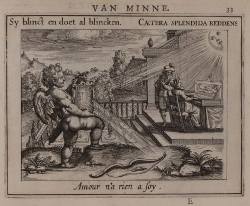
"Zy blinckt, en doet al blincken"
engraving from P. C. Hooft
Emblemata Amatoria, 1611
Although not all of Vermeer's paintings utilize symbolism, literary references and background paintings to enhance the theme of his compositions, The Music Lesson has connections to multiple non-pictorial sources.
Vermeer expert Arthur K. Wheelock Jr. identifies an emblem entitled "Zyblinckt, en doet al blincken" (it shines and makes everything shine) from P. C. Hooft's Emblemata Amatoria as a likely link.
Wheelock observes, "Hooft's emblem showcases two vignettes: a Cupid in the foreground holding a mirror that reflects sun rays, and in the background, a man stands close to a woman playing a keyboard instrument. The accompanying verses convey that just as a mirror reflects the sunlight it catches, love mirrors its source in the beloved. The love one feels does not originate from oneself but from the object of one's affection. While the image of Cupid with the mirror is a literal representation of Hooft's verses, the background figures—a man intently watching his beloved, deeply affected by her music—offer a metaphorical expansion. The compositional similarities between the emblem and The Music Lesson hint that Vermeer held a comparable notion when creating his piece. The background figures in the emblem strongly resemble those in The Music Lesson. Moreover, the emblem's focus on the mirror echoes the significant presence of the woman's reflection in the mirror in Vermeer's artwork."
Vermeer's shadows

In representational painting, there are two basic kinds of shadows: those attached to the objects and those projected by the objects. Attached shadows lie directly on the objects, determined by their shape, spatial orientation and distance from the light source. Perceptually, attached and projected shadows differ significantly. The attached shadow is perceived as an integral part of the object, so much so that it is typically overlooked in everyday observation. Conversely, a cast shadow is interpreted as an interference by one object upon another. One of the primary challenges for painters is deciding the color and paint quality to depict them both accurately.
A cast shadow not only pinpoints the location of an object in space more precisely, but it also introduces distinct shapes and forms, which can be adapted into compositional elements. Vermeer appears to have had a particular fascination with cast shadows, and art specialists have observed that he often modified their shapes to align with his compositional objectives.
In The Music Lesson, a shadow extends from the window toward the tiled floor, with its path slightly disrupted by the left corner of the standing virginal. These diagonal lines significantly contribute to connecting the right side of the composition, filled with various objects, to the empty left side.
In the same work of art, there's an example of another phenomenon showcasing Vermeer's keen observation skills and interest in cast shadows: the double shadow of the ebony-framed mirror. The broader, external shadow results from the sharp angle of the incoming light from the window closer to the background wall. This shadow is somewhat diffused, producing the double shadow effect, because the light from the central window illuminates part of the original shadow. This same phenomenon is evident in the shadows cast by the virginal's right-hand lid. Comparable double shadows are visible in The Concert and A Lady Standing at a Virginal.
Artists were generally discouraged from using double shadows as they might confuse the viewer.
Vermeer, geometry & Piet Mondriaan

Tableau 2
Piet Mondrian
1922
Oil on canvas, 55.6 x 53.4 cm.
Solomon R. Guggenheim Museum, New York
Art connoisseurs have long highlighted the remarkable sense of geometry that pervades Vermeer's compositions. In the work of no other European painter do we find an equal prevalence of straight lines, rectangles and triangles, both real and implied. Perhaps for this reason, Vermeer's art had been championed by some exponents of the art-for-art's-sake movement, which had banished didactic, moral or utilitarian functions from the artist's creed. The American painter Philip Hale wrote: "if ever a man believed in art for art's sake, it was he. He anticipated the modern idea of impersonality in art...he makes no comment on the picture. One does not see by his composition what he thought of it all." As late as 1981, Arthur K. Wheelock Jr. wrote that although abstract design principles are generally associated with the 20th century, "One cannot approach The Music Lesson without realizing that Vermeer calculated his compositional elements every bit as carefully as did Mondrian."
Curiously, 17th-century art writings make little no mention of geometric organization of the painting's surface. As art historian Paul Taylor has written, composition, or ordenitie as it was called, was first and foremost a matter of choosing and arranging the motifs so that they might clarify and strengthen the painting's narrative, not its aesthetic or visual balance. Does this mean that Vermeer was not aware of the geometrical order of his compositions?
Although we do not know how aware Vermeer was, geometry had gained importance in philosophical and scientific circles. As Norbert Schneider observed, "One need only to think of the subtitle of Spinoza's Ethics: 'ordine geometrico demonstrata' (arranged according to geometric principles). Spinoza asserts that ethics can be based on a geometric model in which axioms and propositions follow each other with logical necessity. At that time, geometry stood for clarity and demonstrability, values that may have appealed to Vermeer.
A Vermeer in Venice
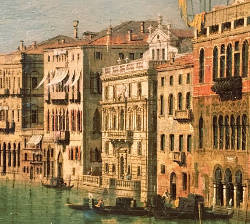
The Grand Canal looking North-West from near the Rialto
Canaletto
c. 1726–1727
Oil on canvas, 47.9 x 80.0 cm.
The Royal Collection, London
Some time after it was sold at the Dissius auction in 1696, The Music Lesson was acquired by Venetian artist Giovanni Antonio Pellegrini in 1718. His art collection was later purchased by Joseph Smith, the British Consul to the Venetian Republic. Smith was a patron of artists, collector, connoisseur, banker and a significant attraction on the British Grand Tour. The Music Lesson has been part of the Royal Collection of Great Britain since 1762 when King George III bought Smith's collection of paintings. When the painting was acquired by the King, it was believed to be a work by Frans van Mieris the elder due to a misinterpretation of the signature. It was not correctly attributed to Vermeer until 1866 by Théophile Thoré, though some scholars were skeptical about the attribution.
Smith, who lived like a Venetian aristocrat, played a pivotal role in launching the career of the Italian vedutista Antonio Canaletto. Smith's house was on the Grand Canal, known as Palazzo Mangilli-Valmaranah. After renting the palace for many years, Smith finally acquired it from the Balbi family in 1740. He then commissioned Visentini to renovate and redesign the structure, culminating in a Palladian façade. After work was completed in 1751, Smith evidently asked Canaletto (likely upon his return from London in 1755) to repaint a detail of the painting. The thicker paint with deep incisions is evident. One can't help but wonder if Vermeer's Music Lesson ever graced the walls of that house. Did Canaletto ever lay eyes on it? Would he have pondered how his northern counterpart achieved such a remarkable perspective? Both painters gave significant attention to accurate perspective and used perspective as an expressive tool.


